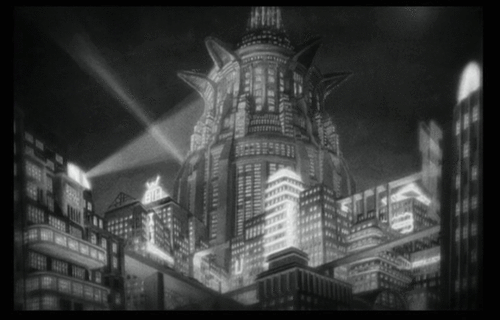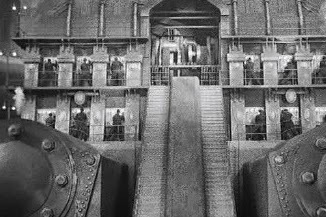Hot-Desking Dehumanizes Work Place
 The "Doc" Hot desking on "Doc Zone"In my 2006 science fiction short story
Virtually Yours
, Kathryn works, drone-like and faceless, in a corporation where workers like her typically find random virtual workstations and access virtual support and form virtual relationships. Anonymous to even her own overseer—she is just a number to him—Kathryn pines for a sense of place, identity, recognition and purpose. I won’t tell you how it ends. In any case, it’s just a science fiction story. Or is it?...
The "Doc" Hot desking on "Doc Zone"In my 2006 science fiction short story
Virtually Yours
, Kathryn works, drone-like and faceless, in a corporation where workers like her typically find random virtual workstations and access virtual support and form virtual relationships. Anonymous to even her own overseer—she is just a number to him—Kathryn pines for a sense of place, identity, recognition and purpose. I won’t tell you how it ends. In any case, it’s just a science fiction story. Or is it?...In his September 11, 2014, article in the Financial Post , Garry Marr introduces professional services firm Deloitte’s intention to rid itself of offices and have no permanently assigned desks in what’s called hot desking. Described as a “growing trend” in the corporate business sector, the model mandates a worker—including the bosses—to stow their personals in a locker and get assigned a random desk to occupy that day (never the same one—that’s what random means). The concept, according to Mark Whitmore, managing partner with Deloitte, creates more meeting rooms and collaborative space and less personal room, presumably taking advantage of a fairly large office vacancy (30%) during any given day (due to field work, meetings, etc.). The idea is to cram as many workers as possible in an open-space concept where they do their so-called creative thinking and use their locker—down the hall—as their main resource-centre. Whitmore likens it to high school—when students showed up at school, put their stuff in a locker and then figure out what they had to do the rest of the day. “You had gym, you grabbed your gym stuff. You’re going to the library, you’d grab your books,” said Whitmore.
 The workers and the machine
The workers and the machineThis is utterly ridiculous. And extremely ineffective. It also lacks “heart”.
Promoting hot deskingdemonstrates a severe lack of understanding of—or consideration for—the importance of “a sense of place” in engendering a creative working experience. Just as recognition of identity and merit in the work place promote a productive and meaningful working ethic.
The argument against hot desking is not about “territoriality,” as Adam Wasilewski, head of design at Toronto-based W designlab Inc. suggested in the Financial Post article. What is at stake here is something much larger; our very sense of place, of belonging, and of humanity.
 Metropolis TowerDeloitte and other corporations who promote the hot desking model have re-invented the migrant-worker. Someone, who wanders from place to place, never able to ground herself. Never sensing her place—or giving her loyalty. Hot desking destroys worker morale and camaraderie. It also annihilates the ground-breaking creativity that arises spontaneously from co-worker discussions. The creative discoveries generated through casual co-worker interaction cannot be planned by booking a boardroom. You can’t compartmentalize creativity.
Metropolis TowerDeloitte and other corporations who promote the hot desking model have re-invented the migrant-worker. Someone, who wanders from place to place, never able to ground herself. Never sensing her place—or giving her loyalty. Hot desking destroys worker morale and camaraderie. It also annihilates the ground-breaking creativity that arises spontaneously from co-worker discussions. The creative discoveries generated through casual co-worker interaction cannot be planned by booking a boardroom. You can’t compartmentalize creativity. I predict that hot desking will not only reduce creativity at work, but it will exacerbate worker absenteeism, sickness, a cavalier attitude and lack of loyalty. In effect, hot desking will produce someone who doesn’t care: at the most, a “rubber-stamping” drone and at the least a slacker who cheats.
The Australians created the term solastalgia to describe the terrible sadness caused by environmental change or loss. It is a very real distress caused by the lived experience of the transformation of one’s home and loss of a sense of belonging. It’s like feeling homesickness when you’re still at home. Given how much time and effort people regularly put into their workplace, this is Germaine to the office experience.
 Drone workers of the Metropolis machine
Metropolis
, the 1927 classic dystopia by Fritz Lang, is about the social crisis of a world where the selfish “dreams of a few had turned to the curses of many” (Fritz Lang, Metropolis).
Drone workers of the Metropolis machine
Metropolis
, the 1927 classic dystopia by Fritz Lang, is about the social crisis of a world where the selfish “dreams of a few had turned to the curses of many” (Fritz Lang, Metropolis). There is a scene in this evocative film where creative men of antiquity decide to build a monument to the greatness of humanity, high enough to reach the stars and reminiscent of humanity’s hubristic construction of the Tower of Babel. Metropolis is a world dominated by technology and greed, where the bulk of the people are dehumanized workers, who more resemble machines in their jerky rhythmic movements and laconic faces than the oppressed humans they are. The “heart” is missing between the “brain” and the “hands”.
 worker drones in Fritz Lang's "Metropolis"When a corporation removes “the heart” of the workplace from the worker (citing increased efficient use of space) the cost is the very humanity—and productivity—of that place and ultimately the worker in it.
worker drones in Fritz Lang's "Metropolis"When a corporation removes “the heart” of the workplace from the worker (citing increased efficient use of space) the cost is the very humanity—and productivity—of that place and ultimately the worker in it. Hot-desking is just another version of Metropolis .
References:
Marr, Garry. 2014. “Hot desking trend grows: no offices or assigned seating at new Deloitteheadquarters”. Financial Post, September 11, 2014.
Munteanu, Nina. 2002. “Virtually Yours”. First appeared in Issue 15 of Hadrosaur Tales (Dec., 2002); reprinted in Neo-Opsis Science Fiction Magazine (Issue 3, Spring 2004); translated into Polish and reprinted in Nowa Fantastika (January 2006); translated into Hebrew and reprinted in Bli-Panika (2006). Selected for The Best of Neo-Opsis Science Fiction Magazine Anthology (Bundoran Press, 2006); nominated for Canadian Aurora Prix and the Speculative Literature Foundation Fountain Award. Reprinted in “Natural Selection: a collection of short stories” (Pixl Press, 2013). Reprinted in Amazing Stories (Amazing Stories, 2014).
Munteanu, Nina. 2008. "Climate Change--Part 2: Solastalgia". The Alien Next Door, April 1, 2008.
Lang, Fritz. 1927. "Metropolis". Paramount Pictures.
Published on September 13, 2014 21:53
No comments have been added yet.



